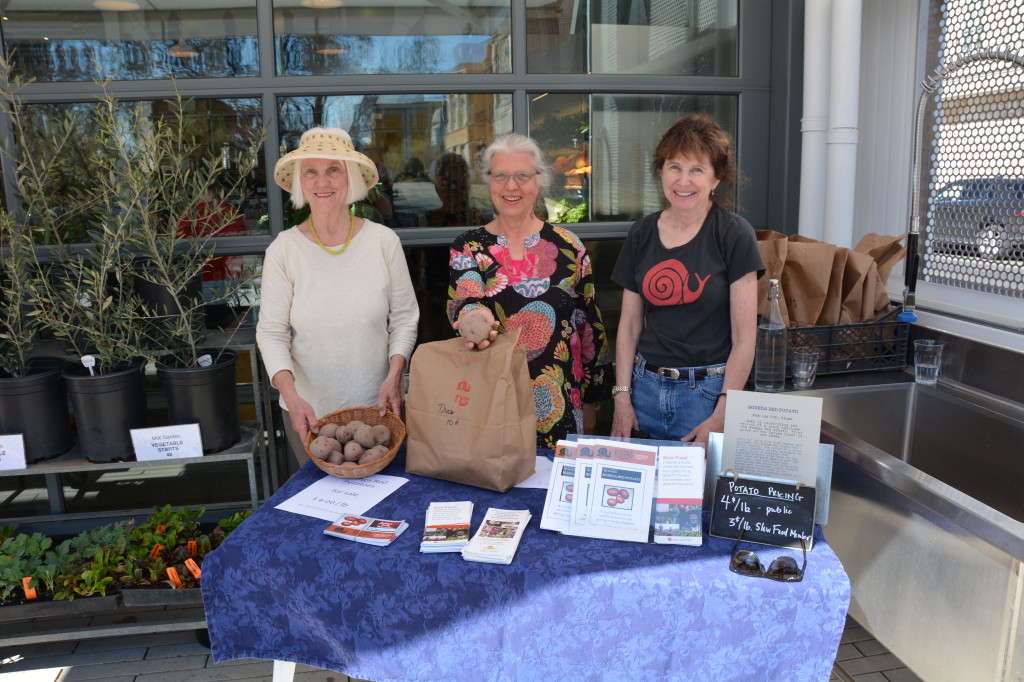Presidium (plural presidia): A protective fortress. A garrison, as in the San Francisco Presidio. From the Latin presidiare, to guard.
The Bodega Red has been a project of Slow Food Sonoma County North since 2006. Through Slow Food’s efforts, a small supply of certified Bodega Red seed potatoes became available in 2013. Since then, Slow Food has placed over 13,500 pounds of seed in the hands of local farmers and gardeners.

Farms Growing Bodega Red Potatoes, 2023
- Armstrong Valley Farm, Santa Rosa (Luther Burbank) Farmers Market
- Asti Road Farm, Geyserville
- Bean Lane Farm, Petaluma
- Bernier Farms, bernierfarms.com, Geyserville
- Bishops Ranch, bishopsranch.org, Healdsburg
- Brisa Ranch, brisaranch.com, Pescadero
- Carrot Top Farm
- Ceres Community Project
- Chiatri de Laguna
- Coyote Family Farm
- Crenn Dining Group
- DaVero Farms & Winery, davero.com, Healdsburg
- Fair Curve Farm
- Farm to Fight Hunger, farmtofighthunger.org, Healdsburg
- Front Porch Farm, fpfarm.com, Healdsburg
- Harvest for the Hungry
- Jackson Family Gardens, kj.com, Fulton
- Kibo Farm
- Laguna Farm
- Little Organic Farm, thelittleorganicfarm.com, Petaluma
- Little Paradise Farm
- Longer Table, longertablefarm.com, Santa Rosa
- Looking Glass Farm
- Occidental Arts and Ecology Center
- Oak Hill Farm
- Pie Ranch
- Pink Barn Farm
- Preston Farm and Winery, prestonfarmandwinery.com, Healdsburg
- Reyes Farm
- Kaz Winery
- Sacramento County Master Gardeners
- Santa Clara County Master Gardeners
- Seven Moons Farm
- SF Napa Valley
- Shamrock Ranch
- Shone Farm, shonefarm.santarosa.edu, Forestville
- Single Thread Farm, singlethreadfarms.com, Healdsburg
- Star Route Farms
- Suncatcher Farm, suncatcherpetaluma.com, Petaluma
- Tierra Vegetables, tierravegetables.com, Windsor
- West County Community Farm
- Winter Sister Farm

History
In the 1840s this Chilean potato jumped ship on the Sonoma County coast and found a home in the farms around Bodega and Tomales Bay. The prosperous crop provided sustenance for Gold Rush miners, inspired squatter wars and made this farming area the potato capital of California. Luther Burbank used the potato as parent material. Named the Bodega Red, the potato became functionally extinct from neglect. Rediscovered in the early 2000s by Slow Food Sonoma County North, the Bodega Red is the focus of a recovery project to re-introduce this heirloom potato to the North Bay food culture: farmers, chefs, gardeners and consumers.
Facts
Documentation – Identified by a research geneticist at the USDA as a unique potato related to others native to Chile
Appearance – Pink-red skin; slightly flattened and oblong; white flesh
Taste – Thin skinned, rich potato flavor; creamy and nutty, excellent texture – neither waxy nor starchy
Uses – Versatile – steam, roast, boil, fry, mash, bake (bread), distill (vodka)
2020 local plantings – 4500 pounds of certified seed
Yield – Approximately 8 pounds per 1 pound planted
Harvest – June for new potatoes; into September for mature spuds
Farm sales – 2019 harvest sold out at $3-4 pound
Distribution – Slow Food Sonoma County North distributes certified Bodega Red seed potatoes annually, in March
Presidium – One of six projects in the USA selected for Presidium status by Slow Food’s Foundation for Biodiversity
Contact: Barbara Bowman
KRCB North Bay Report: Local Potato Variety Stages Comeback from near Extinction-Interview with Elissa Rubin-Mahon & Emmett Hopkins. Bodega Red Potato Interview
Instructions for Planting Bodega Red Seed Potatoes
Planting
- Plant seed potatoes in early spring, in soil that is more than 50°. Best to wait until after the last frost date, unless the soil temperature is above 50. (Usually can’t plant at the coast until the end of May.)
- Seed potatoes
should be the size of an egg to plant, so you will cut each seed potato into
pieces.
- Cut the stem end off; that’s where decay will occur.
- Cut off areas that are funky.
- Doesn’t matter how many eyes are in each piece.
- Dip all potato pieces in wood ashes or oyster-shell lime. Plant them right away.
- Alternatively, let the pieces dry out for 3 days before planting. They may turn green, which is good.
- Potatoes can be planted in rows or intensive checkerboard.
- There should be 30-36” between rows, and about 10-12” between potato pieces (the space between plants affects the size of the potatoes).
- Plant in moist soil, but not saturated. The seed pieces need air. Create rows of hills and trenches, and plant the pieces in the trenches.
Care
- Once the potatoes are planted, don’t irrigate until the plant emerges.
- The most important time to irrigate is when the plants flower.
- Hill the soil around the plants as they get tall and wobbly, around 6-12”, up to their “necks” (so about 2” is showing).
- Any time after flowering, you can reach in and pull out a few tubers.
- Before full harvesting, tuber formation should have stopped. Leaves will be mostly browned.
Storage
- Don’t store the potatoes until the skin is cured (hardened), about 2 weeks. Keep the soil on the potatoes when you store them.
Need help or have questions? Contact Ken, our seed supplier, at kjochimsen@zuckermanfarms.com
Instructions are based on Nathan Boone’s Secrets of Potato Culture Slow Food workshop.